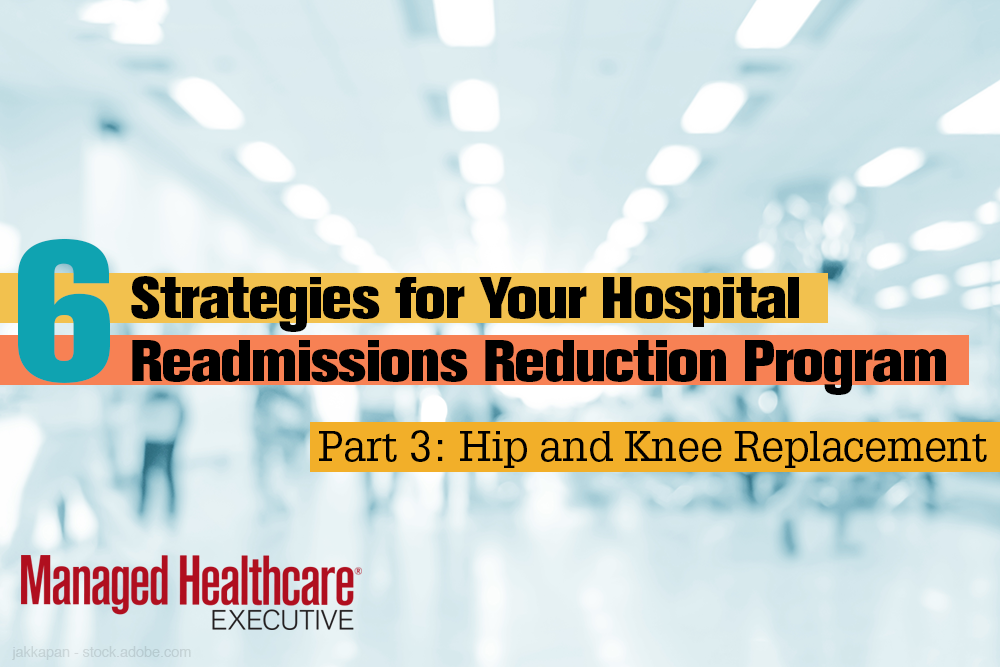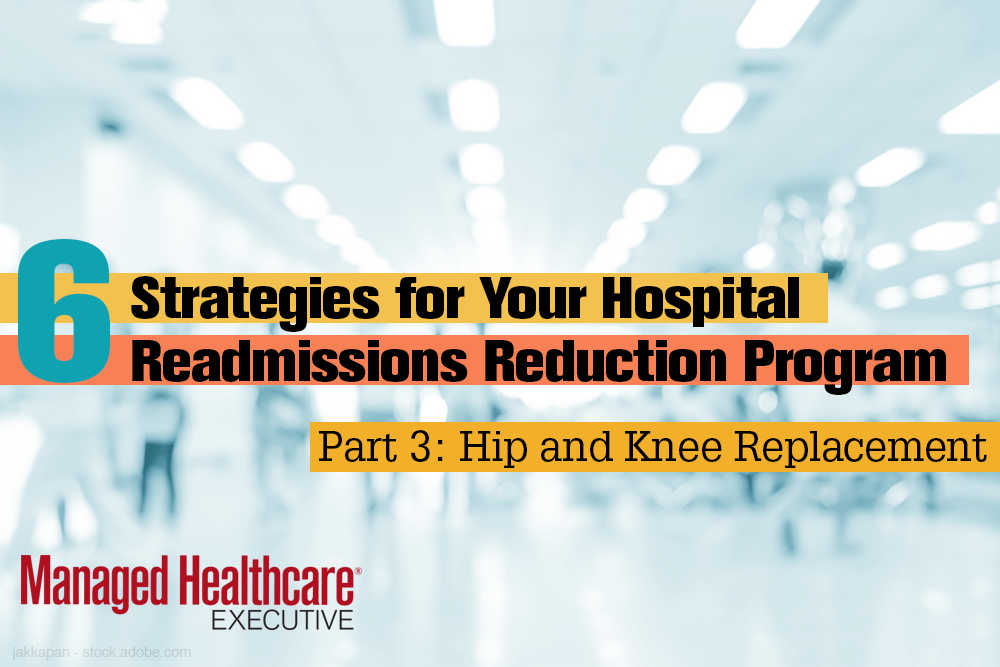Readmission Trends for Hip and Knee Replacement
Encouraging weight loss, smoking cessation, and management of diabetes prior to surgery can help avoid post-operative problems.

In the study, “Improving Quality and Decreasing Cost by Reducing Readmissions in Patients Undergoing Total Joint Arthroplasty,” conducted by the Nebraska Medical Center, several risk factors have been found to contribute to the complication and readmission rates following total joint arthroplasty (TJA), such as obesity, diabetes, and malnutrition. All of these are risk factors in hip and knee replacement readmission as well.
A. Brion Gardner, MD, an orthopaedic surgeon for The Centers for Advanced Orthopaedics in Bethesda, Maryland, says there are a variety of reasons that an individual with a hip or knee replacement may be readmitted. The most serious cause is experiencing a heart attack shortly after surgery, and some patients with preexisting conditions may be more at risk for this.
“Other grounds for readmission include uncontrolled pain, a wound that has drained or is infected, or a blood clot,” he says. “Patients may also be readmitted if there is suspicion of a blood clot or preliminary infection.”
Brian Hallstrom, MD, is co-director of Michigan Arthroplasty Registry Collaborative Quality Initiative (MARCQI), a Blue Cross Blue Shield of Michigan-sponsored, statewide collaborative of hospitals, orthopaedic surgeons, and medical professionals; and clinical assistant professor of orthopaedic surgery at the University of Michigan.
“The most common reasons for hip replacement readmission are fracture, dislocation, blood clots, or other medical complications,” he says. “Knee replacement patients are more likely to come in with pain or blood clots. In both cases, the medical returns are often associated with the patients who experience other medical issues, such as diabetes or heart disease.”
Further, constipation is a common problem among post-surgical patients who are placed on opioids, and bowel problems can also be a reason for return to the ED and readmission.
Reimbursement trends for hip and knee replacement
At the Centers for Advanced Orthopaedics, Gardner says it is contracted with Medicare and uses a bundled payment method that has a direct relationship with reimbursement.
“Given that readmissions increase the total cost of care for a 90-day period, this could ultimately impact the organization’s bottom line, depending on what happened and why,” he says. “Also, if the cost of care is too high throughout a set period of time, money may be owed to the government since it then exceeds the target price in the bundled agreement.”
However, when it comes to commercial insurance, readmission is not yet having an impact on reimbursement. Gardner believes in the future, payment may be dependent on performance and quality of care, where reimbursement is withheld for poor outcomes.
Related: 6 Strategies for Your Hospital Readmissions Reduction Program, Part 2
At Blue Cross Blue Shield of Michigan, Tom Leyden, Director II, value partnerships program, said it has developed variable value-based reimbursement (VBR) opportunities for primary care physicians and all specialty types participating in its quality improvement programs.
“For the inaugural program year, we saw 147 orthopaedic surgeons participating in MARCQI receive VBR payments tied to improvements in patients receiving functional assessments and reductions in the percentage of total knee/hip arthroplasty patients sent to ECF/SNFs post-surgery,” he says. “In fact, many of our hospitals are now sending 0% of their patients to SNFs after surgery.”
The second VBR opportunity for orthopaedic surgeons is tied to improvements in overall per member per month medical/surgical cost of care + pharmacy cost; change in cost of care per member per month (PMPM) from the prior year; a single composite score comprised of quality metrics from across many PGIP initiatives; proportion of visits with primary diagnosis of low back pain receiving an imaging study; and adult MRI and CT imaging per 1,000 member years.
“Finally, we have piloted a bundled payment arrangement for non-complicated hip and knee replacement procedures,” Leyden says. “The goal of the pilot program is to address the significant variation in cost and care across hospitals and geographies. We are working with surgeons and healthcare systems to manage the cost and outcome variation of these procedures (including readmissions), and to consider appropriate sites for care.”
Case Studies: Successful Hip and Knee Replacement Readmissions Reduction Programs
Gardner has seen great success in reducing the number of hip and knee replacements that result in readmission by performing surveillance on the patient.
“At my care center, there is a physician assistant who tracks and monitors the patients receiving hip and knee replacements, calling to check in on patients’ progress, comfort with prescribed medications, and physical therapy schedule,” he says. “Using a laptop or smart device, patients also have access to a platform where they can submit any symptoms they are experiencing.”
If any submitted symptoms are red flags, the patient would then receive a phone call. He also encourages patients to call him on his cell at any time of day in order to avoid any unnecessary visits to the ER.
“On the front end, we also do everything possible to ensure that the patient receiving surgery is medically optimized to do so,” Gardner says. “In advance, they must go to their primary care doctor to assess their current cardiac, pulmonary, and renal status, and address any other concerns. This ensures avoidable post-surgery risks are minimized.”
Hallstrom says there are sites participating in MARCQI that have staff dedicated to focusing on pain management. This includes early follow-up phone calls from nurse coordinators.
“The intent of these calls is to catch trouble early, assist the patients, and avoid returns to the hospital,” he says. “Other Michigan sites have focused on reducing opioid-related constipation with education and by providing stool softener kits to patients. When patients receive better care, and have better outcomes, there is less opportunity for complications and a need to return to the hospital.”
Leyden says the MARCQI collaborative has engaged in an ongoing effort to improve the quality of care for all patients undergoing hip and knee replacement in Michigan and these efforts succeed because the surgeons, nurses, data abstractors, quality teams, and other participants work together to achieve meaningful quality improvement goals.
The collaboration allows for efforts to continually be refined, driving further progress, which is evident in the results MARCQI has experienced to-date, including 18% reduction in 30-day readmissions; 17% reduction in ED visits within 30 days (hip); 52% reduction in VTE events; and 88% reduction in infections.
Managing risk factors to drive down hip and knee replacement 30-day readmissions
The pre-operative evaluation done with the patient’s primary care doctor is essential for identifying and treating any risk factors, Gardner says. With hip and knee replacements, there are well-known perimeters.
“For example, a BMI over 40 increases the risk of blood clots, wound complications, dislocations, and nerve injury,” he says. “In diabetics, a hemoglobin A1C that is above 8 significantly increases the potential risks and must be lowered before proceeding with surgery. In addition, if the absolute levels of protein in the body are not high enough, we would postpone surgery until the lab values are below the threshold for minimizing risk factors.”
Stephen Fealy, MD, leading orthopaedic surgeon at Hospital for Special Surgery in New York, says one of the best ways to manage and mitigate the risk of readmission after orthopaedic surgery is to ensure patients have access to and receive physical therapy as expeditiously as possible.
“When you’re dealing with musculoskeletal injuries and surgeries, the healing process can be complex, long-term, and often requires recurring specialized attention and practice, such as safe incremental exercise to help patients gain back and maintain their strength and range of motion,” he says. “The sooner this can start, the better off the patient will be in both the near- and long-term.”
Hallstrom notes the first, and best step, is optimizing patients prior to surgery. Things like weight loss, smoking cessation, and controlling diabetes before surgery are all ways to help avoid post-operative problems.
Keith Loria is an award-winning journalist who has been writing for major newspapers and magazines for close to 20 years.

This week on Tuning Into The C-Suite Briana Contreras spoke with Dr. Scott Hayworth, president and CEO of New York-based CareMount Medical. In this interview, the two discussed the importance of patients staying in contact with their doctors for the sake of reducing public health risks and to discuss ongoing care options with them.
Listen
Eric Levin talks PBMs and how Scripta is Tackling the Market's Challenges for Patients
July 22nd 2020MHE's Briana Contreras spoke with CEO of Scripta, Eric Levin. The two discussed the current state of the pharmacy benefit market and how the Scripta organization has been assisting its clients and their prescriptions prior to the COVID-19 pandemic and during.
Listen

















